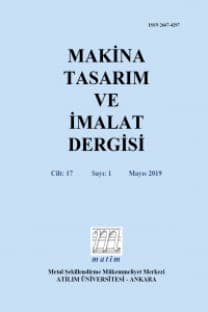Kelebek Vanaların Simülasyon Destekli Deney Tasarımı ve Prototip Üretimi
Vana sektöründe tesisatların çabuk açılıp kapanmasını sağlamak ve bu şekilde su ve enerji kaybını azaltmak amacıyla tasarlanan kelebek vanalar isimlerini klape ve milin yerleşim şekillerinden almaktadır. Yaygın olarak kullanılan sfero döküm klape malzemelerin düşük korozyon direncini arttırmak amacıyla rilsan veya epoksi kaplama gibi alternatif yöntemlere başvurulsa da bu opsiyonlarla istenilen korozyon dayanıma ulaşmak mümkün olmamakla birlikte vananın sızdırmazlık fonksiyonlarını da tam olarak yerine getiremediği tespit edilmiştir. Korozyon direncini arttırmak ve sızdırmazlık fonksiyonlarını iyileştirmek amacıyla kullanılan paslanmaz çelik klapeler ise uzun tedarik süreleri, yüksek maliyetleri ve talaşlı imalat işleme zorlukları sebebiyle çok tercih edilememektedir. Bronz klapeler düşük maliyetleri, kısa termin süreleri ve kolay talaşlı imalat özellikleri sebebiyle kritik bir öneme sahiptir. Diğer yandan sfero dökme demir gövde malzemelerinin korozif ortam ile temas eden kısımlarının kauçuk malzeme ile kaplanarak korozyon dirençlerinin arttırılması ve sızdırmazlık fonksiyonlarını yerine getirmesi de sektörde yaygın olarak tercih edilmektedir. Bu çalışmada Lug-Wafer tipi kelebek vanaların sfero dökme demir gövde tasarımı, bronz klapelerin sıcak dövme yöntemi ile üretiminin simülasyon destekli tasarımları ile prototip üretim aşamaları ele alınmış, gövde ve klapenin temas yüzeylerindeki sızdırmazlığı sağlamak amacıyla plastik pres ile EPDM kaplama ölçülerinin ıslak torka etkileri deney tasarımı ile araştırılmış ve sistemin optimum ıslak tork değeri tespit edilmiştir.
Anahtar Kelimeler:
Kelebek Vana, Simülasyon Destekli Tasarım, Bronz, Islak Tork, Simulation Assisted Design, Bronze, Wet Torque
Simulation Assisted Experiment Design and Prototype Production of Butterfly Valves
Butterfly valves, which are designed to enable the installations to open and close quickly in the valve industry and thus reduce water and energy loss, take their names from the placement of the disc and shaft. Although alternative methods such as rilsan or epoxy coating are used in order to increase the low corrosion resistance of commonly used ductile cast iron disc materials, it impossible to reach the required corrosion resistance with these options, and it has been determined that the valve cannot fully fulfill its sealing functions. Stainless steel discs, which are used to increase corrosion resistance and improve sealing functions, are not preferred because of long lead times, high costs and machining difficulties. Bronze discs are of critical importance due to their low cost, short lead times and easy machining. Moreover, it is widely preferred in sector to increase the corrosion resistance and fulfill the sealing functions by coating the parts of the ductile cast iron body materials that come into contact with the corrosive environment with rubber material. In this study, ductile cast iron body design of Lug-Wafer type butterfly valves, simulation-supported designs of the production of bronze discs by hot forging method and prototype production stages are discussed, the effects of the pressed EPDM coating dimensions on the wet torque were investigated with the experimental design to ensure the sealing on the body contact surfaces and the disc, and the optimum wet torque value of the system was determined.
Keywords:
Kelebek Vana, Simülasyon Destekli Tasarım, Bronz, Islak Tork, Simulation Assisted Design, Bronze, Wet Torque,
___
- 1. Ünlü C., Tesisat Mühendisliği Dergisi, 86 (2005), 83-86, İstanbul
- 2. Chern, M. J., Wang, C. C., and Ma, C. H., Performance Test and flow Visualization of Ball Valve, Exp Therm. and Fluid Sci. 31 (2007), 505-512.
- 3. Skousen, P.L., Valve Handbook: Flow Characteristics, p. 18-19, Newyork, 1998.
- 4. Oflaz, M., 2009, İTÜ Fen Bilimleri Enstitüsü Yüksek Lisans Tezi, Yaylı Emniyet Vanalarında Sızdırmazlığın Sağlanması İçin Kapatma Elemanı Kombinasyonunun Deneysel Olarak Belirlenmesi, 11-12.
- 5. Skousen, P.L., 1998. Valve Handbook: Manual Butterfly Valves, p. 111-121, Newyork, 1998.
- 6. Bozacı, A., Makina Elemanlar: Yaylar, Seç Yayın Dağıtım, cilt 1(2000), 8.1- 8.15.
- 7. Sandalcı, M., Effect of the Flow Conditıons and Valve Size on Butterfly Valve Performance, Isı Bilimi ve Tekniği Dergisi, 30 (2010) 2, 103-112.
- 8. Filo, Grzegorz, Edward Lisowski, and Janusz Rajda. "Design and flow analysis of an adjustable check valve by means of CFD method." Energies 14.8 (2021): 2237.
- 9. Li, Yongjian, et al. "Microstructure characteristics and mechanical properties of new-type FeNiCr laser cladding alloy coating on nodular cast iron." Journal of Materials Processing Technology 269 (2019): 163-171.
- 10. Menaa, A., et al. "CFD analysis of hydrogen injection pressure and valve profile law effects on backfire and pre-ignition phenomena in hydrogen-diesel dual fuel engine." International Journal of Hydrogen Energy 44.18 (2019): 9408-9422.
- 11. Ye, Yang, et al. "Suppressing the generation of cavitation by increasing the number of inlet check valves in piezoelectric pumps." Sensors and Actuators A: Physical 293 (2019): 56-61.
- 12. Zhang, Sha, et al. "Transient numerical investigation of a large-scale hydro-pneumatic suspension considering variations in check valve parameters and operational conditions." International Journal of Numerical Methods for Heat & Fluid Flow 30.4 (2019): 1967-1990.
- 13. Kim, Nam-Seok, and Yong-Hoon Jeong. "An investigation of pressure build-up effects due to check valve’s closing characteristics using dynamic mesh techniques of CFD." Annals of Nuclear Energy 152 (2021): 107996.
- 14. Li, Shuxun, et al. "Analysis and Optimization of the Opening Dynamic Characteristics of Molten Salt Check Valves for Concentrating Solar Power." Applied Sciences 13.5 (2023): 3146.
- 15. Chamas, Ali, et al. "High temperature/pressure MAS-NMR for the study of dynamic processes in mixed phase systems." Magnetic Resonance Imaging 56 (2019): 37-44.
- 16. Bhowmik, Palash K., and Kune Y. Suh. "Flow mapping using 3D full-scale CFD simulation and hydrodynamic experiments of an ultra-supercritical turbine’s combined valve for nuclear power plant." International Journal of Energy and Environmental Engineering 12.3 (2021): 365-381.
- 17. Gök, O., 2014, Kelebek vanaların optimizasyonu ve yeni bir kelebek vana tasarımı, Yüksek Lisans Tezi, Cumhuriyet Üniversitesi Fen Bilimleri Enstitüsü, Sivas, 39-44.
- ISSN: 1302-9487
- Başlangıç: 1986
- Yayıncı: Makina Tasarım ve İmalat Derneği
Sayıdaki Diğer Makaleler
Faruk ELALDI, Süleyman Alper KALE
Tornalanmış yüzey imgeleri gri ton ortalama değerlerinin takım aşınması ile ilişkisinin incelenmesi
Muzaffer Tacettin KÜLLAÇ, Olkan ÇUVALCI
Yeni Bir Hibrid Metasezgisel Algoritma İle Drone Kolunun Yapısal Optimizasyonu
Savunma Sanayiinde Katmanlı İmalat ile Tedarik Zinciri Yönetimi
Kelebek Vanaların Simülasyon Destekli Deney Tasarımı ve Prototip Üretimi
